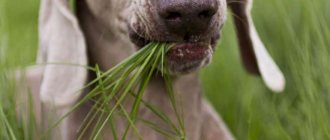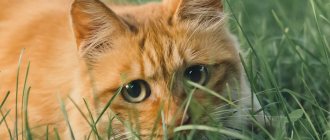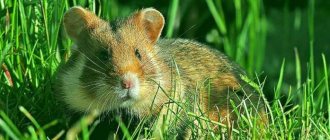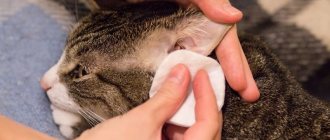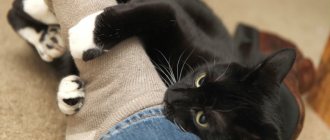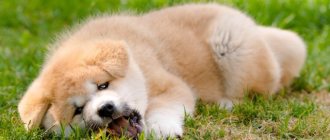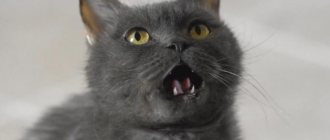Veterinarians don't know why dogs eat grass, but they can pinpoint factors that aren't responsible for the sudden craving for greens. Experts say that:
- A dog eats grass not because of a lack of vitamins. The gastrointestinal tract of dogs simply does not contain enzymes capable of digesting greens.
- Four-legged animals eat greens, regardless of diet and type of food. This is evidenced by recent studies.
- The pet does not try to get rid of worms. Absolutely healthy dogs have a passion for green spaces.
Why does a dog eat grass?
There are several reasons why a dog eats grass. You can get acquainted with them below.
Lack of fiber
If an animal eats an unbalanced diet, it suffers from a lack of fiber. This element is necessary for the quadruped for the normal functioning of the entire organism. According to observations, dogs whose owners feed high-quality food chew plants less often or do not pay attention to them at all.
Stomach cleansing
With a large amount of food, your pet may experience stomach discomfort. By eating greens, the weevil tries to induce vomiting and empty its stomach. Don't be alarmed if your dog eats grass and vomits it. But sound the alarm if your dog vomits several times after eating greens.
I like the taste
Our smaller brothers also have their own taste preferences, which can sometimes be strange. Some dogs just love the taste of greens. Therefore, in this case, a dog eating grass should not be alarming.
Play, especially in puppies
In puppyhood, dogs actively explore the world; they, like human children, want to put everything in their mouths. The puppy is also very interested in what every object that surrounds him tastes like.
Probable disease
The four-legged dog feels bad due to a number of diseases, so if the dog eats grass, it means that it wants to alleviate its condition a little. Observe your pet: does he show any other signs of illness (lack of appetite, lethargy, problems with bowel movements, etc.)?
Do not prevent your animal from eating outdoor vegetation if it feels fine afterwards. But pay attention if your pet eats greens too greedily. Sometimes owners may believe that their pet is so plaintively asking to go outside because it wants to go to the toilet.
But imagine their surprise when the pug runs headlong to a place overgrown with blades of grass and eats it like it was the last time. In this case, you better consult a veterinarian and ask him why the dog eats grass so frantically. It is quite possible that the dog liked the greens so much for a reason and will have to undergo a series of tests.
If your pet bothers you with its behavior while walking, try making adjustments to its diet first. Reduce the amount of meat, add more vegetables (except potatoes). Instead of cheap food that has virtually no vitamins and minerals, buy at least premium food.
Instinctive behavior
Another type of grass eating is believed to be
It's more of an instinctive behavior. It is believed that this is a deliberate attempt to induce vomiting after they have ingested something that makes them feel sick. Perhaps your dog is suffering from an upset stomach and his instinct is to toss as a form of relief.
Dogs that eat a lot of green grass to induce vomiting will usually swallow it as quickly as possible without even chewing it. It is believed that long, hard pieces of grass tickle their throats to stimulate vomiting.
What grass can dogs eat?
Now it has become a little clearer why dogs eat grass and why they behave a little strangely. Now we need to find out which greenfinch can be safely eaten by weevils.
Most plants do not pose a threat to pets, but this does not mean that you can allow your ward to eat whatever he wants.
Here is a list of what the wet nose can safely eat:
- sow thistle;
- wheatgrass;
- nettle;
- Rowan;
- chamomile;
- calendula;
- beet or carrot tops;
- mint, dill, parsley;
- rose hip;
- milk thistle;
- linden flowers;
- Valerina;
- dandelion;
- sprouted rye, wheat and oats.
It is very important that the plants grow in an environmentally friendly place away from roads and factories - and are not treated with chemicals. Only then will it be safe for your dog to eat grass.
Benefits for the body
Eating a bunch of grass is also useful for combating constipation. An inactive lifestyle and an unbalanced diet can cause difficulties with bowel movements. The large amount of fiber and moisture contained in eaten greens helps cleanse the intestines.
From the stomach, unprocessed grass enters the intestines, swells and moves feces towards the exit.
When a pet eats grass and burps, in addition to the dangerous contents of the stomach, it also gets rid of excess bile. In this way, its stagnation in the body is prevented.
By observing during a walk, you can notice what grass dogs eat most often and what they prefer. This:
- meadow grasses with hard leaves - wheatgrass, bluegrass, sow thistle;
- cereals - oats or wheat;
- vegetable leaves - beets, carrots, lettuce, nettles;
- the heads of some flowers are cornflower or calendula.
Some breeds - wolfhounds, Samoyeds, Malamutes - are able to find medicinal plants. They dig up Jerusalem artichoke, valerian roots, tear and eat clover heads.
However, it should be remembered that there are also poisonous plants. They can get into a dog’s mouth at home, on the street or in their garden.
What plants are dangerous?
When asked if dogs can eat grass, all veterinarians will tell you yes. But not just any plant will do. Adults usually feel that eating greens will make them feel bad, so they don’t risk trying them. But puppies and young animals may eat it purely out of curiosity.
The list of dangerous plants includes:
- horse chestnut;
- lupine;
- buttercup;
- buckwheat;
- poppy;
- clover;
- iris;
- horsetail;
- cornflowers;
- alfalfa;
- belladonna;
- henbane black.
If your pet does ingest a poisonous plant, you need to neutralize the poison as quickly as possible. It will be better if you take your four-legged animal to the veterinary clinic without delay.
But even if the wet-nose has eaten non-hazardous vegetation, there is a risk of infection by parasites, since there may be excrement of other animals on the surface of the greenery.
Does this phenomenon pose a danger to the health of the animal?
Eating greens is a normal process for dogs and does not need to be prohibited. Animals instinctively know what suits them. Potential risks can be prevented:
- Avoid flower beds, fenced areas in parks and squares, where chemicals are often used.
- Do not let your pet into the thickets of grass, there are a lot of snails and slugs from which they become infected with helminths. There is also a high chance of catching ticks or getting injured.
Herbal medicine for four-legged animals
Not only people are treated with herbs - they are ideal as a gentle therapy for dogs. In some cases, herbs can help faster and more effectively than medications. However, the appropriateness of such treatment must be confirmed by a veterinarian. If a four-legged animal is diagnosed with a serious illness, then traditional medicine fades into the background.
Non-dangerous sores can easily be cured with herbs, but only if you are sure that they will help your animal. Under no circumstances should you give plants that you are not sure are safe. If some infusion or mixture helped you, this does not mean that it will help your dog.
If your pet loves to eat street vegetation, try to walk it away from the roads. It will be much better if you start growing greenflies for your pet yourself. At least you will be sure that it is clean and safe, and if the dog is used to eating grass outside, he will probably stop doing it.
Allow or not
Even if you are sure that your dog eats properly and gets everything it needs from food, in my opinion, it is okay to allow your dog to “pinch” the grass. Of course, greens should not be allowed to be consumed as a substitute for the main meal. But nothing bad will happen from a few blades of grass eaten with pleasure. Moreover, many dogs get great pleasure from the taste and smell of this or that herb. It happens that our Jack likes to “get caught” in a clearing and pick another blade of grass. But he does this extremely rarely. Maybe because he already gets enough vegetables and fresh herbs.
When should you contact a veterinarian?
If a four-legged animal ate green grass and remained just as active and restless after that, then there is no danger.
However, if he chewed vegetation and then vomited repeatedly, you should run to the vet immediately. Most likely, what was eaten was poisonous or toxic. The veterinarian will neutralize the effect of the poison and prescribe the correct treatment.
You should also sound the alarm if you observe the following symptoms after your dog eats grass:
- refusal to eat;
- lethargy, apathy, reluctance to do anything;
- elevated temperature;
- convulsions;
- blueness of mucous membranes;
- there is blood in the stool and vomit;
- constipation for a long time;
- constant diarrhea;
- sudden weight loss;
- change in coat (too hard, starting to shed heavily, excessively tousled, etc.);
- repeated vomiting.
These signs may indicate dangerous infectious diseases or poisoning. You definitely can’t do this without visiting a specialist.
Precautionary measures
Indoor flowers such as dieffenbachia, monstera, and oleander contain calcium oxalates, needle-like formations on the stems, and extremely poisonous juice. Upon contact with mucous membranes, they cause a burning sensation, pain, and vomiting. If the poisonous oleander juice gets into the dog's digestive tract, it may die.
Dangerous flowers should be kept completely out of reach of your pet.
On a personal plot, a dog can also be in danger. Garden crops are fertilized and sprayed against pests.
At the dacha, you need to carefully monitor your pet; it is better to block his access to the garden beds to avoid poisoning.
While walking in the city or in the park, you can also come across a clearing treated with insecticides. Also, the leaves may contain eggs of worms or parasites, which can cause severe infectious diseases.
You should not allow your pet to chew grass that grows near highways. There is a high concentration of toxic substances from exhaust gases.
It is necessary to regularly carry out prevention against worms. Along with the grass you eat, there is a high probability that parasite eggs will enter your body.
Analogs from a pet store
Sprouted seeds of cereals and other crops are often sold in pet stores. You can be completely confident in the safety of this greenery. And if your pet doesn’t like the grass, you don’t have to throw it away. Transplant it into a larger pot and use it as a decorative element in your home.
The consultants in the store will tell you which greenback will suit your four-legged friend. They will also advise you on this or that plant if your dog has any health problems.
It would be a good idea to buy greens at any supermarket. This is about:
- Celery: Its stalk has anti-inflammatory properties. Indispensable for older pets suffering from arthritis.
- Parsley: it is rich in manganese, phosphorus, calcium, potassium and folic acid, which is very necessary for the health of dogs. Parsley also helps prevent unpleasant odor from an animal's mouth.
- Dill: since dill has a specific taste, animals do not always agree to eat it. But dill helps increase appetite and improve the functioning of the digestive system and kidneys.
- Basil: It contains vitamins B2 and C, potassium, calcium, iron, folic acid and magnesium. Like dill, basil improves digestion and increases appetite. Some feed manufacturers add basil to their products.
Don't give your wet-nose greens unless you're sure he needs them. It is better to discuss this point with your veterinarian. As a useful additive, you can finely chop dill or parsley in small quantities and add it to the food.
Take care of your dog's health - become a gardener
Dogs are capable of trying to replace grass in ways available to them. They may eat plastic bags or strings. These substitutes are dangerous as they can cause volvulus or other mechanical damage. It is necessary to provide the pet with the opportunity to find the necessary greenery. At the same time, it is better to walk in clean grassy areas, away from highways and walking areas of other pets.
If this is not possible, you can give the dogs your own grass. Pet stores offer a large selection of grass seeds for pets. Within two weeks after planting, sprouts will appear. It will be possible to supplement your pet’s diet without any health concerns.
Owners who feed their dogs the wrong, poorly balanced food should review the menu. If your diet contains a lot of carbohydrates, you need to reduce their volume to 20% of your total daily diet. At the same time, you need to increase the intake of proteins. They should be up to 50-70% and come mainly with meat.
Misconception of dog breeders
Most breeders think there is nothing unnatural about this:
- The animal thus replenishes its supply of vitamins;
- Gets rid of worms;
- Tries to clean teeth of food debris.
There are many versions of why, but veterinarians refute them, although there is no exact explanation for this.
Here are at least two reasons
, explaining that teeth and vitamins have nothing to do with it:
- The dog does not have the necessary enzymes in its stomach to process grass, so it practically does not get anything useful from it. In addition, those dogs who have the most balanced food also engage in “grass-eating”;
- An animal cannot brush its teeth with plants, since by nature it is a predator, its jaw is designed to tear and bite, and its teeth are located quite sparsely, blades of grass will simply slip between them.
Disputes on this topic are still ongoing; there are only more or less plausible explanations for why this is necessary. We will talk about them below.
What to watch out for
The first is the frequency of such manipulations. If your pet tries to clean himself this way during every walk, it's time to review his diet and show him to the vet. It is possible that she is at risk of serious diseases of the gastrointestinal tract, or that the diet is chosen incorrectly.
The second is the purity of the grass itself. Outside the city, you can allow your dog to eat grass, but only if it is vaccinated. In urban environments, a lot of dust, dirt and chemicals settle on greenery. In addition, other factors should not be excluded: someone could spill poison, a sick animal could sleep on this grass or mark it.
